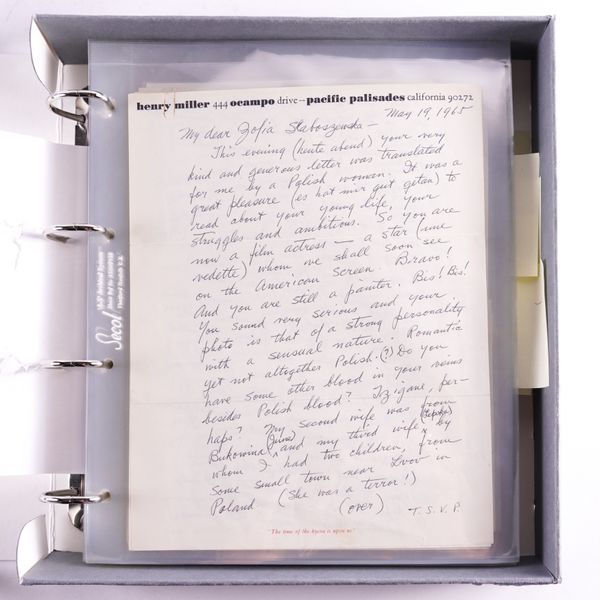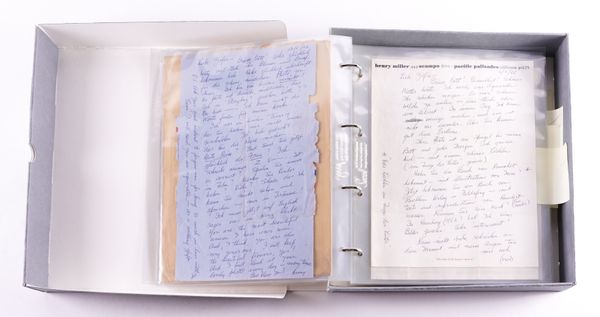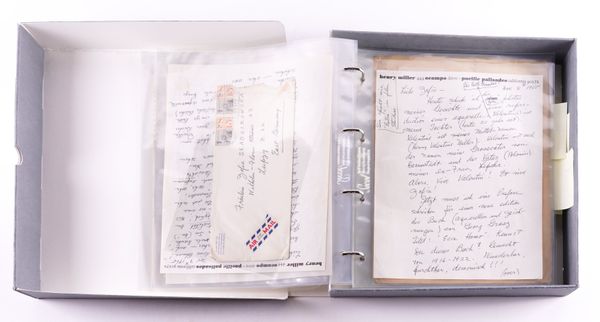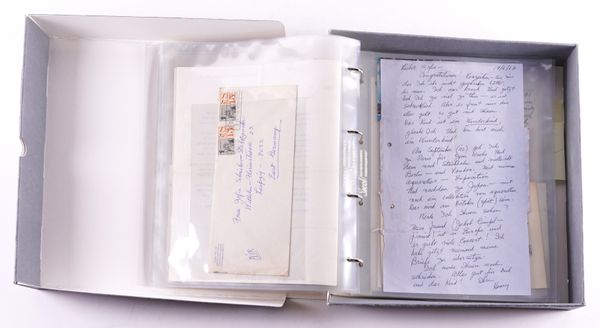MILLER, Henry (1891-1980). A series of 38 autograph and typed letters, all but one signed ("Henry Miller", "Henry" etc.), to Zofia Slaboszowska, Pacific Palisades, 19 May 1965-13 November 1979, c.63 pages in total.
| Estimate: | £3,000 - £5,000 |
| Hammer price: | £1,400 |
MILLER, Henry (1891-1980). A series of 38 autograph and typed letters, all but one signed ("Henry Miller", "Henry", "Heinrich von Mueller", "Heinrich der Knarr", "Henry-san", "Heinrich von Offenbach"), to Zofia Slaboszowska (later Schreiber), Pacific Palisades, 19 May 1965-13 November 1979. c.63 pages in total, various sizes, chiefly 280 x 215mm and 139 x 215mm, in German (20), English (13), Polish (4 letters typed on his behalf by his friend Jakob Gimpel), and French (one, a postcard); with envelopes. [With:] two autograph letters, signed, to Zofia’s sister-in-law [And:] two printed postcards signed and addressed in autograph; a letter translated into German and copied on his behalf by his friend Emil White; pamphlet for an exhibition tour, "How About Paris with Henry Miller?", inscribed in autograph; four photographs (three inscribed or endorsed by him). "Thrice-blessed Zofia! ... Ask your good husband to forgive me for being so much in love with you ... I will look at your lovely photograph every day": Miller’s decades-long epistolary flirtation with the Polish actress Zofia Slaboszowska, with whom he began exchanging letters after seeing her photograph in Playboy Magazine. The letters chart Miller’s infatuation with the actress – "you are the most beautiful woman I have ever seen"; "I cannot find the words for my thoughts" – and his distress upon hearing details of her marriage to the German author Helmut Schreiber. The early letters extol Zofia’s great beauty and sensuality in particular – "you are impossibly beautiful … Hail to the most beautiful Pole!", professing in French that she is "the very likeness of the woman of my dreams". He thanks her for sending him photographs ("it makes it easier to write to you"; "your many photographs adorn my mirror") and makes plans for them to meet in Paris while he is in Europe. He suggests that they communicate in German so that she can better understand him, later rebuking himself for writing such "terrible" German despite it being his mother-tongue and remarks on the difficulties of finding a good Polish translator. He discusses the merits of various languages, ranking Polish more beautiful than German and English "apart from when the Irish speak it. Then it’s poetry!". He ruminates on love and marriage ("Marriage is always good as long as it doesn’t last too long"), and laments their mutual marital strife ("nothing is wrong with marriage per se, only with us"), later recounting stories of his multiple previous wives ("she was a terror!"). The letters contain discussion of the pair’s artistic pursuits, with Miller promising to send her a Russian translation of "Tropic of Cancer" ("the one which caused so much trouble and sensation") alongside extensive discussions of the book’s film adaptation. He lauds her "many talents" ("A pianist, a painter, a poet and a playwright!"), and encourages her painting, expressing particular fascination in a lithograph of "an old man with a walking stick". He sends her numerous examples of his own "aquarelles", and states that his paintings have become more erotically charged in his twilight years. Near the end of the correspondence he remarks rather poignantly of his own art "maybe when you get very close to death you think more strongly about love. I am always in love with someone". The later letters slip into English more frequently as Miller’s health deteriorates and he loses sight in one eye. He becomes melancholy around his 80th birthday ("[I am] a big fool who loves wine, women and song") despite his shared celebrations with his friend Lawrence Durrell ("we drank champagne for ten days"). Miller’s early passion for Zofia’s beauty evolves into genuine fondness in the later letters, consoling her when her artistic career fails to take-off ("I am sorry your paintings do not sell. But you must not be discouraged – one day the world will discover your talent I’m sure") and giving her advice on finding a dealer for her work ("Paris really isn’t as important as you think"). He expresses admiration for her family values ("you have chosen the right kind of life – the simple one. And so you are thrice blessed"), referring to her as the "Leipzig Madonna" after the birth of her first child. He discusses Leipzig and East Germany throughout, describing the situation ("sad, very sad"), and humorously expresses frustration at the East German censors blocking his correspondence ("It is easier to send a man to the moon than a letter to Leipzig"). The letters finish on a pensive note, with Miller closing his final letter to Zofia, one of the last written before his death in 1980: "life is still good, but I suspect World War III is on its way". Zofia Slaboszowska first appeared in Playboy Magazine in March 1964; her photograph in this edition is likely that which initially prompted Miller to begin their correspondence. Slaboszowska subsequently appeared in around 15 film and television productions, predominantly in the DDR, and her ink drawing "Rosa-Luxemburg" was later exhibited at the VII. Ausstellung der DDR in 1972/73. Miller appears to have had a particular interest in Playboy at the time; the magazine published his short story "The Old Neighbourhood" in 1965. Miller also conducted over the last four years of his life an intimate correspondence with the Playboy model Brenda Venus. The letters contain references to several notable contemporaries and associates of Miller, including the celebrated Polish pianist Jakob Gimpel, Miller’s long-time friend and here his Polish translator. Miller’s close friendship with the British writer Lawrence Durrell, who he first met in 1937 and with whom he stayed on Corfu between 1939 and 1940, is the subject of a humorous anecdote on the occasion of Miller’s 80th birthday in these letters. Miller in his later years was known for hosting significant artistic and literary figures at his Pacific Palisades residence; the letters make reference to numerous personalities of the time including Jane Fonda, Henry Fonda, Roger Vadim and Rhonda Fleming. The "astrological friend" to whom Miller refers may be Sidney Omarr, who acted as Miller’s personal astrologist throughout the 1960s and 70s. The "Japanese lady" whom Miller describes meeting and falling in love with is likely his fifth wife, the Japanese born singer Hoki Tokuda, whom he married in 1967 and divorced in 1977. The letters make reference to the 1970 film adaptation of Miller’s autobiographical novel "Tropic of Cancer", which starred Rip Torn and James T. Callahan and was directed by Joseph Strick. The "aquarelles" which Miller references form part of an oeuvre comprising an estimated 2,000 watercolours painted during his lifetime. Miller also wrote a number of books on the subject, one of which, "To Paint Is To Love", is referred to in these letters. The exhibition tour to which Miller refers (and the advertisement for which is included in this lot) is his 1967 tour of Europe, the author’s first international exhibition of his watercolours. 50 or more major collections of Miller’s paintings are said to exist, with the Harry Ransom Center at the University of Texas and what was the Henry Miller Museum of Art in Japan holding significant selections. Please note that only a small part of the lot is illustrated. Provenance: Sotheby's, New York, 15 July 1999, lot 369.




